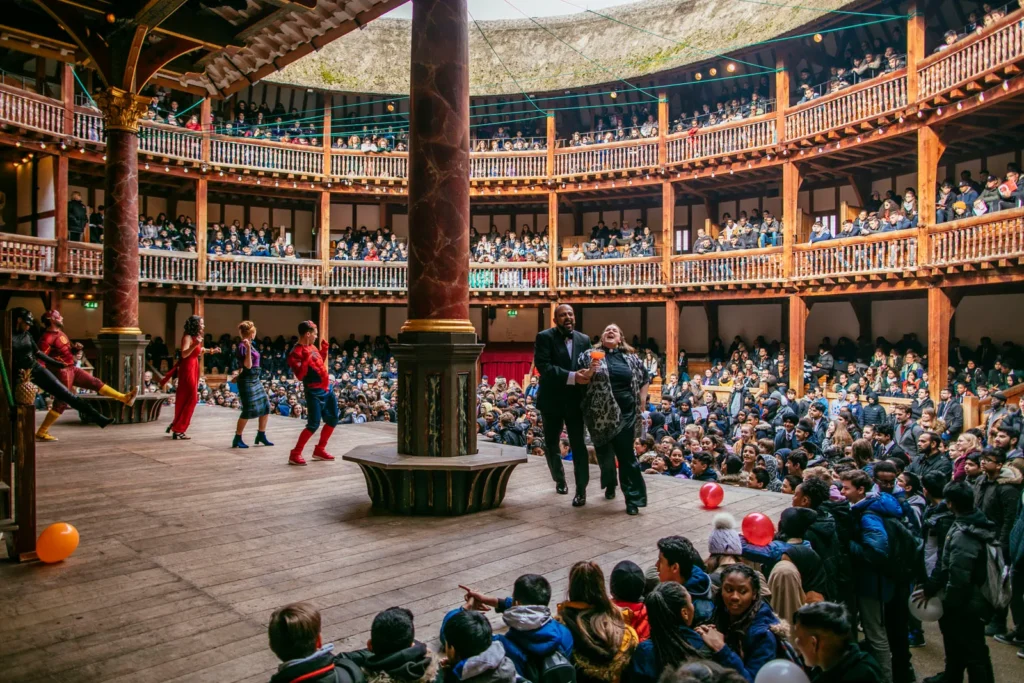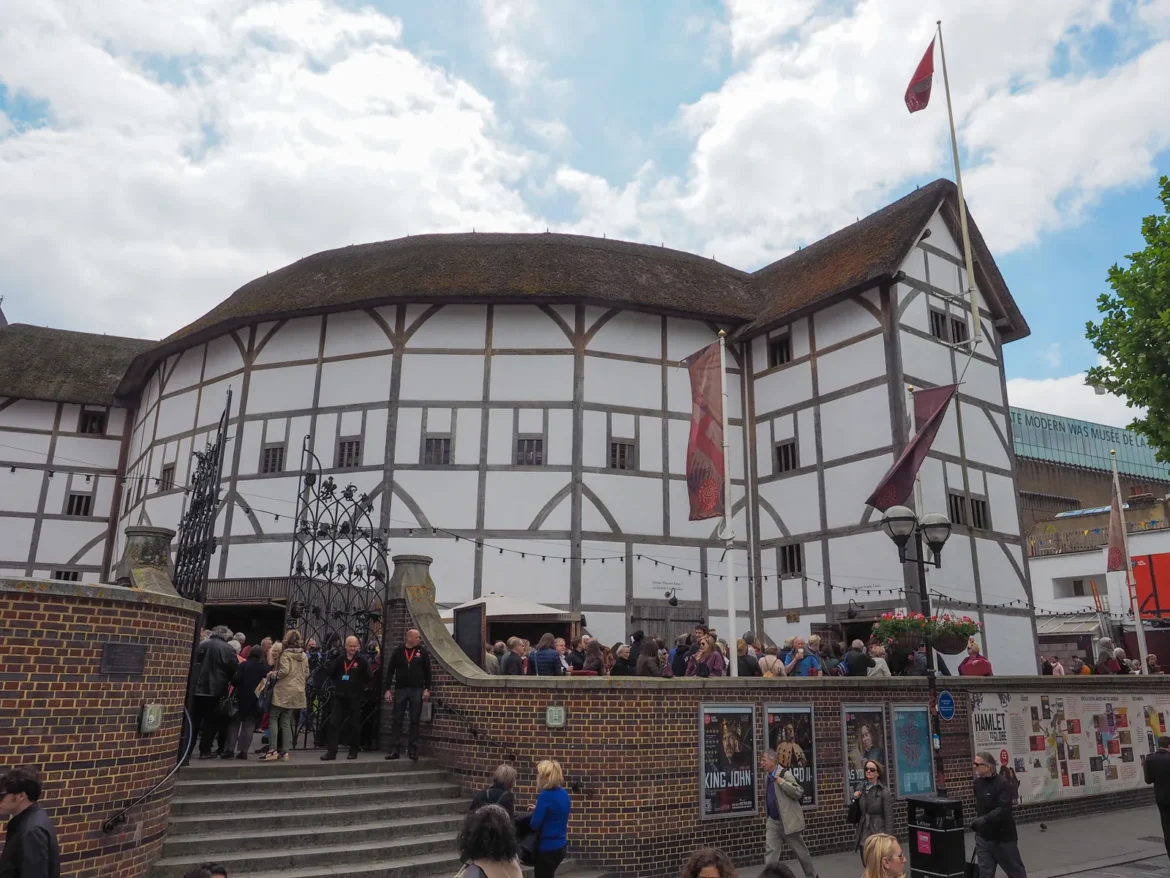Shakespeare’s Globe is one of London’s most iconic and culturally significant landmarks. Situated on the south bank of the River Thames, near London Bridge, it is a modern reconstruction of the original Globe Theatre, which was co-founded by William Shakespeare in 1599. This theatre serves not only as a venue for performances of Shakespeare’s plays but also as an educational and cultural hub that preserves the traditions of Elizabethan theatre for contemporary audiences. The Globe stands as a testament to Shakespeare’s enduring legacy, showcasing the vibrancy, drama, and innovation of his works while offering a unique window into the world of 16th and 17th-century theatre.

Historical Background
The original Globe Theatre was established in 1599 by a group of actors, including William Shakespeare, who was also a shareholder. It was located in Southwark, an area outside the jurisdiction of the strict City of London authorities, which allowed for more artistic freedom. The Globe was a wooden, open-air amphitheatre designed to host the popular plays of the time, drawing audiences from all social strata—from commoners standing in the yard to wealthy patrons occupying the galleries.
Shakespeare’s Globe became famous for its innovative productions and the sheer energy of its performances. The theatre was home to many of Shakespeare’s most renowned plays, including Hamlet, Othello, Macbeth, and King Lear. Unfortunately, the original Globe met a tragic end when it burned down in 1613 during a performance of Henry VIII after a misfired theatrical cannon ignited the thatched roof. It was rebuilt a year later, only to be closed permanently in 1642 by the Puritans, who considered theatre morally suspect.
For centuries, the Globe existed in memory and historical records, with scholars and theatre enthusiasts piecing together its layout, design, and performance practices. The 20th century, however, witnessed a remarkable revival of interest in recreating the Globe, led by the tireless efforts of American actor and director Sam Wanamaker.
The Rebirth of the Globe
Sam Wanamaker’s vision to reconstruct the Globe was driven by a desire to preserve the authenticity of Shakespearean theatre. Wanamaker meticulously researched historical documents, drawings, and accounts of Elizabethan performances. His work culminated in the reconstruction of Shakespeare’s Globe, which officially opened to the public in 1997, nearly 400 years after the original theatre was destroyed. The modern Globe stands just 230 meters from the original site and is widely recognized as one of the most faithful reconstructions of a 16th-century theatre.
The reconstruction process prioritized historical accuracy. Traditional building methods and materials were used wherever possible: timber frames were crafted using ancient carpentry techniques, lime mortar replaced modern cement, and a thatched roof—a rarity in London due to fire regulations—was carefully constructed with a state-of-the-art sprinkler system to ensure safety. The result is a visually stunning theatre that closely mirrors what audiences would have experienced in Shakespeare’s day, complete with an open-air yard and surrounding galleries.
Architectural Design
Shakespeare’s Globe is a marvel of Elizabethan architecture. Its circular design, often referred to as an “amphitheatre,” allows the stage to be surrounded on three sides by the audience, creating an intimate and immersive theatrical experience. The theatre can accommodate approximately 1,400 spectators, including groundlings who stand in the yard and higher-paying attendees who sit in the tiered galleries. This layout mirrors the social stratification of the Elizabethan era while ensuring that every audience member has a unique and personal connection to the performance.
The stage itself is a large, projecting platform that extends into the audience, allowing for dynamic interactions between actors and spectators. The stage is roofed—known as the “heavens”—and features intricate painted decorations, including zodiac signs and cherubs. Above the stage, trapdoors and a balcony provide additional space for creative staging, enabling scenes such as ghostly apparitions and dramatic entrances that were a hallmark of Shakespeare’s original productions. The theatre’s open-air design not only authenticates the historical experience but also allows natural light to illuminate daytime performances, creating a magical and ever-changing atmosphere.
Performances and Programming
Shakespeare’s Globe is renowned for its vibrant and diverse theatrical programming. While the primary focus remains on Shakespeare’s works, the theatre also stages plays by his contemporaries and adaptations of modern works that align with the spirit of Elizabethan theatre. Productions are performed using a combination of traditional practices and innovative interpretations, often incorporating live music, elaborate costumes, and minimalistic sets to emphasize the power of language and performance.
A key feature of performances at the Globe is adherence to historical practices. Actors speak in Early Modern English, and performances often rely on natural acoustics rather than amplified sound. The use of gender-neutral and flexible casting, as well as live music performed on period instruments, further enhances the authenticity of the experience. The theatre also embraces interactive and immersive techniques, encouraging audience participation and breaking the fourth wall—a practice common in Elizabethan performances.
Education and Outreach
Beyond its role as a performance venue, Shakespeare’s Globe is a center for education, research, and community engagement. The Globe Education program offers workshops, courses, and resources for students, teachers, and theatre professionals. These programs cover acting techniques, stagecraft, textual analysis, and historical context, providing invaluable insight into Shakespeare’s works and the Elizabethan theatre tradition.
The Globe also houses an exhibition and a reconstruction of the theatre’s historic interiors, allowing visitors to explore the architecture, costume designs, and stage machinery. The exhibition highlights the evolution of Shakespearean theatre, the life of actors in the 16th and 17th centuries, and the cultural impact of the Globe across centuries.
Cultural and Historical Significance
Shakespeare’s Globe occupies a unique position in London’s cultural landscape. It serves as a bridge between the past and the present, preserving Elizabethan performance traditions while remaining relevant to contemporary audiences. The theatre’s commitment to historical accuracy, combined with innovative programming, has made it a global symbol of Shakespearean art and a center for international scholarship.
The Globe’s influence extends beyond the stage. It has inspired countless adaptations, academic studies, and cultural initiatives worldwide, promoting a deeper understanding of Shakespeare’s works and their universal themes. The theatre’s annual festivals, special events, and collaborations with artists from around the world further solidify its status as a living, breathing institution dedicated to the arts.
Modern Relevance
In today’s digital and fast-paced world, Shakespeare’s Globe offers an invaluable reminder of the timeless power of live theatre. Its productions draw audiences from across the globe, including tourists, students, and theatre enthusiasts. The Globe also hosts online streaming events and digital educational resources, ensuring accessibility and engagement even for those unable to visit in person.
Moreover, the Globe emphasizes sustainability and community engagement. It promotes environmentally responsible practices in theatre production and supports local artists and performers, fostering a vibrant creative ecosystem. By combining historical authenticity with modern relevance, Shakespeare’s Globe exemplifies how heritage and innovation can coexist harmoniously.
Conclusion
Shakespeare’s Globe is more than just a theatre; it is a cultural landmark, an educational institution, and a living tribute to the genius of William Shakespeare. From its historical origins in 1599 to its painstaking reconstruction in the 20th century, the Globe embodies the enduring appeal of theatre and the transformative power of storytelling. Its architectural beauty, commitment to historical authenticity, and dedication to education and community engagement make it a must-visit destination for anyone interested in literature, history, and the performing arts.
By recreating the sights, sounds, and spirit of Elizabethan theatre, Shakespeare’s Globe allows audiences to experience the works of the world’s greatest playwright as they were intended to be seen. It is a place where history comes alive, language resonates across centuries, and the magic of live performance continues to captivate and inspire. Whether you are a lifelong Shakespeare enthusiast, a student of theatre, or a curious visitor, Shakespeare’s Globe offers a unique opportunity to connect with the past, celebrate the present, and imagine the possibilities of performance for generations to come.

